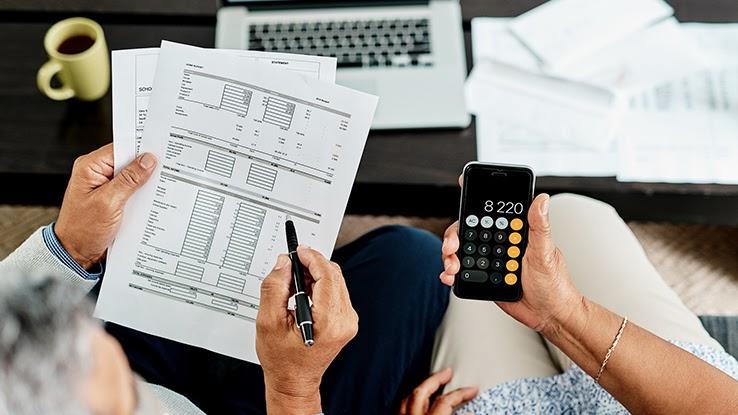How To Create A Facebook Form

Budgeting is a pretty consistent buzzword in the world of personal finance — but there's a good reason for that. Your budget is the financial foundation you need to build to learn how to manage your money before you begin pursuing other financial goals. And creating a budget can help you reach a wide number of your financial goals, too. From saving for a down payment on a new home to paying off debts like student loans, a budget is an amazing tool to help you plan out and track (or even minimize) your spending. After creating a budget, you may be surprised to see where your money's going — but you'll be glad you found out.
The hardest part about budgeting is actually getting started for most people; questions like "what should a beginner budget look like?" and "what is a balanced budget?" make this entire process seem very daunting. Today, we'll show you how to get started by creating a household budget form that breaks down your finances into different categories for housing, transportation, utilities, and more. You'll be one step closer to reaching your financial goals after you create this form.

To create a simple household budget form, open a spreadsheet on your computer and add several columns. The first thing you'll do when creating your budget is to list out all your regular expenses. These are bills you pay at structured intervals, such as once a month, with amounts that generally don't vary too much. Start with the larger expenses, such as your rent or mortgage payment. Keep going with everything from your car to your group fitness classes to your streaming subscriptions. Go through several months of bank statements and credit card bills to gain a better understanding of your spending habits.
It's difficult to get the full picture for a household budget form if you don't include bills and expenses that can vary from interval to interval, too. When it comes to credit cards, add the minimum payment as an expense, but also include your total balance. If your minimum payment is $100 but you've been paying $200 a month for the last few months, write $200 down. If you pay off your card balance every month but the amount varies widely, you can take the average from the previous three or six months to use as a starting point.
Next to this list, you'll also need a column for different forms of income you receive. Write down your salary, wages, tips, rent from a roommate and any other income you receive here. Once you've listed everything, you'll be able to see how your income compares to your budget.
Categorize Your Expenses

Once you have everything listed in your household budget form, it's time to categorize different expenses. Housing, transportation, utilities, health and fitness, entertainment, groceries, and personal care should all be accounted for in terms of categorization of spending. Remember that housing expenses may also include HOA fees, insurance and taxes. Children, pets or loved ones you may be caring for also need their own categories — daycare fees, school tuition and Fluffy's monthly grooming are all expenses.
Once you have your categories listed in your household budget form, it's time to put everything in its place. To help determine your grocery budget, for example, go through and look back a few months. Average this out and be generous. Be as truthful as possible so you have a realistic picture of what you're spending.
To dive even deeper into this, you can color-code your expenses by fixed and non-fixed categories. A fixed expense is something like a mortgage payment or a student loan that won't change from month to month. An expense like a monthly massage or a subscription to a coffee shop isn't a fixed expense, though. These are extras you can easily scale back on if you need to, and their amounts might change greatly from month to month.
See Where There's Room to Improve

There's always room to improve your household budget form. Add up your totals to see how much income you have and what you're spending. Start by highlighting anything you think you can cut back on or remove. If your budget is airtight already, that's great. This means you may already have a healthy savings rate. You can go back to that and make a plan for your disposable income.
If you feel you're spending too much, however, make a plan for removing or cutting back on what you've highlighted. This will help make paying off your debt a priority. Maybe you didn't remember you're paying for a yoga class you haven't gone to in a few months or you're still paying for a streaming service you no longer use. Be realistic about your intentions, and don't be afraid to cancel what you're not using. Note these and make a plan to cancel them — it'll feel great seeing that money go back into your budget.
Focus on Your Goals Using a Household Budget Calculator

The main reason to have a household budget form is to help you reach your financial goals. Now that you have your budget in place, it's time to make those goals if you haven't already. The main goal might be to buy a home, but you'll want to include some smaller goals here that'll help you achieve the bigger goal. Think of your small goals as steps on a ladder.
If your main goal is to buy a home, your smaller goals could be to boost your credit score, pay off your other debts to reduce your debt-to-income ratio and save for a down payment. You'll then make a plan for any extra income you have after doing your budget. Go back through your budget and bump up your minimum credit card payments. Next, make savings automatic by transferring a set amount from your checking account to your savings account each paycheck.
To stay on track, set a date for a monthly meeting with yourself to review your finances. These regular check-ins will help you stick to your budget. If you don't go back through your budget, you may find you forgot to cancel a fitness class you meant to cancel or you overspent on eating out that month. A budget works best if you follow through and use it to create a plan for the future. It's also a great way to track your progress. At your check-in, you may find your savings account has grown nicely due to your automatic deposits. This is a great tool to help you stay motivated.
Make Sure the Form Works for You

A household budget form won't look the same for everyone. The key is to find a budget template that works for you. Whether you want it color-coded like a rainbow or written out old-school on paper, this is completely up to you. The key is to make sure it encompasses all your spending and it's organized in a way that makes you actually want to use it.
If you're doing this process with a partner, ensure they have access as well. If you're saving for retirement and your spouse is overspending on hobby supplies, you aren't on the same page. Keep in mind that your small goals are just as important as your big goals — and every month you can stick to your budget, you're one step closer to reaching them.
MORE FROM ASKMONEY.COM
How To Create A Facebook Form
Source: https://www.askmoney.com/budgeting/create-basic-household-budget-form?utm_content=params%3Ao%3D1465803%26ad%3DdirN%26qo%3DserpIndex
Posted by: weidmanatudeas.blogspot.com

0 Response to "How To Create A Facebook Form"
Post a Comment